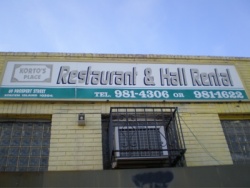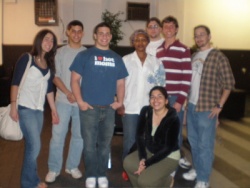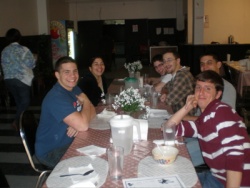Food
From The Peopling of New York City
West African Food
The different tastes and aromas of West African food is due to the variety of trade going on in those countries. European traders introduced beans and maize, while Asian people brought cinnamon, pepper, and nutmeg to the West African civilization. Due to the ethnic diversity, in Nigeria, there isn’t just one national dish. There are, however, foods that are available only during certain seasons and those that are a dime a dozen such as pineapples, bananas, mangoes, and limes. Still, almost 8% of the population of Nigeria is considered malnutritioned.
Muslims, living in Nigeria, focus their diets towards beans, rice and other skewered meat. Other natives enjoy pumpkin dishes as well as dumplings made of “cassava powder” and yams (Isu). People living near the coastline enjoy a variety of stews that consists of seafood, such as shrimp and clams. These soups go by the name of “Efo”. All these meat and rice is marinated in ginger and peanut oils in order to bring out the exotic tastes.
Nigerians buy their foods from street vendors, restaurants, or peddlers. These dishes come in a range of colors and smells. “Moin-moin” is a steamed cake, consisting of ground beans and fish. “Ukwaka” is a pudding made of corn and plantains. Chilies are in most of the dishes and a phrase heard around the country is “The man that eats no pepper is weak, pepper is the staff of life...". During feasts, West African cuisine consists of yams (iyan), liver, rice and chicken stew (jollof), and goat meat (obe didn). To finish everything off, teas and coffee is a must.
The daily routine for most of the West African civilization consists of waking up at five in the morning for breakfast, made up of fruits such as fried plantains (dodo). The rest of the daily courses are usually cooked on an open fire, and eaten with hands, even egusi (famous soup). It’s made of meat, chilies, shrimp, and greens. The best cuisines of the day are the snacks. West African snacking traditions range from chili dip to an assortment of meats to fried peanut spheres. Chinchin are fried pastries, akara is a deep fried cake made of peas, suya is spicy meat on a skewer, and kulikui is deep fried peanut paste. Food is scarce, in certain communities, and most of the time children are fed first. Street venders, selling cookies and fruits, allow for children to eat during the day, in order to have enough energy to travel long distances, form destination to the next. Fast food is also becoming very popular in Western Africa.
The meals cooked in the homes of the natives of West Africa aren’t just cooked for friends and family, but for any dwellers passing by the region.
The Visit to Korto's Place
Korto's Place is a restaurant located on the north shore of Staten Island. Located on a side street from the main road, it's not easily found unless looked for. We're lucky indeed, then, that we looked for this little hidden treasure. The restaurant served as a window into life in Liberia, or at the very least, the foods of Liberia and the rest of the west African region, going beyond even the previous research we had done into Liberian food, and the customs surrounding food. Indeed, immediately upon walking into Korto's Place, we were greeted by a wonderfully polite woman, who welcomed us and encouraged us to try the different foods available that day before deciding on our meals.
Map showing the location of Korto's Place
The food, although simple, did not quite match up exactly with our research but instead served as an example of the variation of style that exists in any culinary community. The basic staples were there - cassava, fish, spinach, etc. The biggest surprise, though, was the fufu. This was a dough-like substance formed into ball form and served with a chicken soup of sorts. It was made of yams, though any starchy vegetable will usually suffice. (A quick side-observation - this seems a common feature of all cultures, the doughy, starchy substance: pasta in Italy, potatoes in Ireland, dumplings (sans meat) in China, etc.) Fufu was by far the favorite of those of us who ate there that night, though there were some among us who ate what others could not finish. For those that were brave enough to try it (all were, but some were braver than others), there was a pepper-based spicy sauce that could be mixed with the spinach portions of everyone's meals. Finally, there was dessert - fried plantains. This cousin to the banana, delicious on it's own, is a typical Liberian dessert and when fried is simply exquisite. Altogether, then, the food more or less reflected what we'd found in our prior research.
Though the food was quite important, the social atmosphere of the restaurant should not be ignored. As was previously mentioned, we entered the restaurant near the end of the day, on a non-busy day of the week. However, the hall (for that's what the restaurant really was - an open hall with several tables in it) was still impressive in it's own right. It's a largely open space with the several tables, a stage that can be used for different performances (or sometimes, as we learned, for karaoke), and a bar area that is in service for the parties that are sometimes held there. It may also be that we were all under the age for the legal consumption of alcohol. But no matter. The atmosphere seemed to be familial, as if if we were to come on a busy night, it would not be as several different groups of people eating in the same restaurant, but several members of a largely extended family eating together in the same room. Again, this reflects the hospitably welcoming nature of the Liberian community.
And so you can see, though the visit to Korto's Place showed us differences that exist between individual Liberians and what is labeled as "typical," we also saw clearly demonstrated some of the best of what Liberian culture can be, and certainly tasted what seemed to us the best of Liberian foods.


